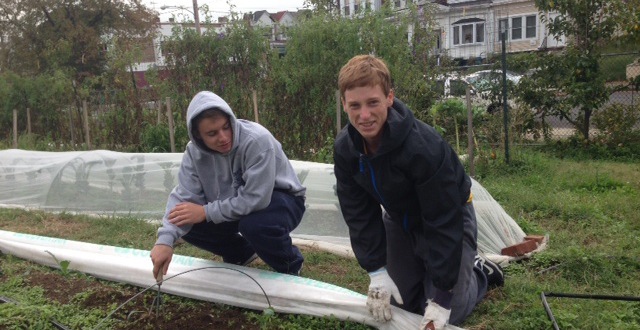
Sam Niu ’15, Eunice Ju ’15, Sarah Wingfield ’17: The Episcopal Academy student body will be honored with the “Outstanding Youth in Philanthropy Award” at the upcoming 28th Annual National Philanthropy Day Awards Gala on November 20th. The Gala, hosted by the Association of Fundraising Professionals, seeks to recognize “service by an individual or group of young people who demonstrate outstanding commitment to the community through direct financial support, development of charitable programs, volunteering and leadership in philanthropy.” The Outstanding Youth in Philanthropy Award will be the second award honoring the Episcopal Academy service program since its inception nearly thirty years ago.
Camphill Special School, one of EA’s service partners, was the organization that nominated the Episcopal Academy for the award. EA has been working with Camphill Special School for about three years. Since then, Camphill has praised the Episcopal Academy volunteers, writing “Episcopal’s our favorite group of people that come to volunteer; they just work so hard and get so much done.” Susan Swanson, Community Outreach Director, credits the award entirely to the student volunteers. “It’s the kids who actually [do] the work and so I’m really proud that they rose to the occasion and worked so hard…. I’m humbled by the work that they do and am thankful that we have the opportunity to do it.”
Swanson also emphasizes the commitment to community service by students.
“Philanthropy is usually giving money away, but we give our time away. We believe in learning by doing. It’s more important to give your time and talents at this age.” Rebecca Brinks, Community Outreach Coordinator, added that “Mrs. Swanson has been doing these programs for quite a few years and it’s nice [they are] finally getting recognized.”
Brinks attributes the success of the community service at EA to the wide range of programs offered. “There are lots of programs that have been offered for many years…and that’s probably most reflective of the [reason why] our community service program is receiving the award.” Swanson also believes that the success of the service program is due to its diverse projects, noting that the school, “[probably has] fifty community partners. [The volunteers] go to the same [organizations] over and over again [and they] establish a good relationship with them. [The organizations] cover a large range: homelessness, hunger, environmental places, the horticulture society, education…”
Despite the thirty years of outstanding community service, as evidenced by the two awards, both Swanson and Brinks believe that, “until [participation] is 100%, it is not enough.” In terms of participation, Swanson says, “There are fifty million people that are hungry in America, so that’s a really big story. There are so many people that [the students] could go to volunteer three times a day and still it’s just a drop in the ocean.” Brinks continues that “[they] would always like to see more participation and hope to inspire people to want to donate their time, to give themselves.”
Brinks finds the most rewarding aspect of the program to be “seeing [the] students get something out of the program, to see them engaged, whether [with] a child they’re tutoring or making conversation with someone at the soup kitchen.” Swanson concluded, “The greatest thing [is] when you see these kids really light up because they’re making a difference and they really feel that.”